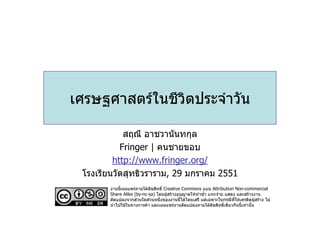
Economics in Daily Life
- 1. เศรษฐศาสตรในชีวิตประจําวัน สฤณี อาชวานันทกุล Fringer | คนชายขอบ http://www.fringer.org/ โรงเรียนวัดสุทธิวราราม, 29 มกราคม 2551 งานนี้เผยแพรภายใตลิขสิทธิ์ Creative Commons แบบ Attribution Non-commercial Share Alike (by-nc-sa) โดยผูสรางอนุญาตใหทําซ้ํา แจกจาย แสดง และสรางงาน ดัดแปลงจากสวนใดสวนหนึ่งของงานนี้ไดโดยเสรี แตเฉพาะในกรณีที่ใหเครดิตผูสราง ไม นําไปใชในทางการคา และเผยแพรงานดัดแปลงภายใตลิขสิทธิ์เดียวกันนี้เทานั้น
- 2. หัวขอชวนคุย 1. เศรษฐศาสตรคืออะไร? 2. กิจกรรมทางเศรษฐกิจ 3. เรื่องของเงิน 4. เรื่องของสินคา 5. วิธีวิทยาของเศรษฐศาสตร
- 4. “โจทยใหญ” ของเศรษฐศาสตร • มนุษยมีความตองการไม สิ้นสุด • แตทรัพยากรมีจํากัด – ที่ดิน &ทรัพยากรธรรมชาติ – แรงงาน – ทุน • ควรใชและจัดสรร ทรัพยากรอยางไร? • เรามีทางเลือกอะไรบาง?
- 5. สมมุติฐานของเศรษฐศาสตร • คนเปน “สัตวเศรษฐกิจ” ? • คน “มีเหตุมีผล”? • ถาสมมุติฐานเหลานี้ไมเปนจริง ทฤษฎีทางเศรษฐศาสตรกอาจ ็ อธิบาย “โลกแหงความจริง” ไมได
- 6. คําถามใหญของเศรษฐศาสตร • ระบอบเศรษฐกิจควรผลิตสินคาและบริการประเภท ใดบาง? – เนนการผลิตในภาคเกษตร หรืออุตสาหกรรม หรือ บริการ? หรือควรเนนกิจกรรมดานกีฬา การพักผอน หรือทีอยู ่ อาศัย? • ระบอบเศรษฐกิจควรผลิตสินคาและบริการอยางไร? – ใช แรงงานเปนหลัก, ที่ดนเปนหลัก, หรือทุนเปนหลัก? ทํา ิ อยางไรใหเกิดประสิทธิภาพ? • ใครควรไดใชสนคาและบริการที่ผลิต? – แบงใหทุกคนได ิ เทาๆ กัน? ใหคนรวยไดมากกวา? ใหคนทํางานหนักได มากกวา?
- 8. Positive & normative economics • Positive Statements: – สามารถพิสูจนวาเปนจริงหรือเท็จได ดวยการเช็คขอมูลหรือ คนควาวิจัยเพิ่มเติม • Normative Statements: – เปน “ความเห็น” หรือ “ความรูสึกสวนตัว” ที่พิสูจนวาเปน จริงหรือเท็จไมไดดวยการคนควาวิจัย ความรูจากงานคนควาวิจัยลาสุดศาสตรอนๆ กําลังชวยขยับขยาย ื่ “พรมแดนความรู” ของเศรษฐศาสตร เทากับแปลง Normative เปน Positive economics เชน happiness economics, behaviorial economics, environmental economics
- 9. “นักเศรษฐศาสตรพูดอะไรก็ได”? Price 6 5 4 3 2 1 0 0 1 2 3 4 5 6 Quantity
- 10. “นักเศรษฐศาสตรพูดอะไรก็ได”? Price 6 S0 S1 5 S2 4 3 2 1 D0 0 0 1 2 3 4 5 6 Quantity
- 11. “นักเศรษฐศาสตรพูดอะไรก็ได”? Price 6 S0 5 4 3 D2 2 D1 1 D0 0 0 1 2 3 4 5 6 Quantity
- 13. บริโภคหรือลงทุน?
- 14. บริโภคหรือลงทุน?
- 15. บริโภคหรือลงทุน?
- 16. บริโภคหรือลงทุน?
- 17. เรื่องของเงิน
- 19. Time Value of Money (TVM) • เงิน 100 บาทในมือวันนี้ มีคามากกวาเงิน 100 บาทที่ จะไดในปหนา เพราะเราสามารถนํา 100 บาทวันนี้ไปใช จาย (บริโภค) หรือลงทุน เชน ฝากธนาคาร • ถาดอกเบียเงินฝาก = 5% ตอป เราจะมีเงินในธนาคาร ้ เทาไรในหนึ่งป? สองป? • เราไมไดเพียงดอกเบี้ยบนเงินตนกอนแรกเทานั้น แตยัง ได “ดอกเบี้ยบนดอกเบี้ย” อีกดวย = “ดอกเบียทบตน” ้ • “กฎ 72” = 72 / ดอกเบียตอป = จํานวนปคราวๆ ทีเงิน ้ ่ จะเพิมเปนสองเทา ่ • สูตรในการหา “มูลคาอนาคต” :
- 21. เงินเฟอ • เงินเฟอ หมายถึงภาวะทีกําลังซือของผูบริโภคลดลง ่ ้ จากการที่ผูบริโภคตองการสินคาและบริการในปริมาณ มากกวาปริมาณทีผูผลิตจะผลิตมาวางขายทันตอความ ่ ตองการ (ลักษณะของระบอบเศรษฐกิจที่กาลังเติบโต) ํ • ถาเราซื้ออะไรไดดวยเงิน 100 บาทในปนี้ ปหนาเราอาจ ตองใชเงินมากกวาเดิมในการซื้อของสิงเดียวกัน ่ • เงินเฟอทําใหของมีราคาแพงขึนเรื่อยๆ ้ • ดังนัน จะรูวาเรา “รวยขึ้น” หรือ “จนลง” จริง จึงดูแต ้ รายไดในกระเปาที่เพิ่มขึนหรือลดลงไมได ตองเทียบ ้ กับอัตราเงินเฟอกอน
- 23. เรื่องของสินคา
- 25. ...และทําไมสตารบัคสถึง “ซอน” สินคา? • ไมมี “SHORT” (ขนาดเล็กสุด) ใน เมนู แตลูกคา สามารถสังได! ่ • สตารบัคสอางวา เมนูไมมีเนือที่พอ ้ ใหใส แตเหตุผลที่ แทจริงคืออะไร? • การ “ซอน” สินคา เปนประโยชนตอ ผูบริโภคอยางไร?
- 26. เมื่อผูซอรูขอมูลนอยกวาผูขาย ื้ “Lemon Car”
- 27. Price Elasticity of Demand ราคา (บาท) จํานวนที่ตองการ
- 28. Price Elasticity of Demand ราคา (บาท) 5 รายได ของผูขาย D 100 จํานวนที่ตองการ
- 29. Price Elasticity of Demand ราคา (บาท) 10 5 D 5 6 จํานวนที่ตองการ
- 30. Price Elasticity of Demand ราคา (บาท) 10 7 D 5 20 จํานวนที่ตองการ
- 31. Income Elasticity of Demand
- 32. Income Elasticity of Demand
- 34. เศรษฐศาสตรเลาเรืองดวยแผนภาพ ่ สิ่งบันเทิง คาใชจายในการบริโภค (บาท) อาหาร O รายไดตอเดือน (บาท)
- 35. เศรษฐศาสตรเลาเรืองดวย Time Series ่ พันลาน บาท ผลิตภัณฑมวลรวมในประเทศและอัตราการสงออกของไทย 8,000 80% 6,000 60% 4,000 40% 2,000 20% 0 0% 2533 2534 2535 2536 2537 2538 2539 2540 2541 2542 2543 2544 2545 2546 2547 2548 GDP ของไทย การส ง ออกเป น ร อ ยละของ GDP ที่มา: กระทรวงพาณิชย, ธนาคารแหงประเทศไทย
- 36. อัตราสวนก็ใช “เลาเรือง” ได ่ อัตราสวนการใชเชื้อเพลิงตอรายไดตอหัว ป 2548 (จํานวนตันหรือเทียบเทา ตอรายได 1 USD) 500 450 400 350 300 250 200 150 100 50 0 อิ น โดนี เ ซี ย สิ งคโปร ฮ อ งกง มาเลเซี ย ไทย อิ น เดี ย ฟ น แลนด ฟ ลิ ป ป น ส เกาหลี ใต สหรั ฐ อเมริ กา ญี่ปุ น จี น อั งกฤษ ที่มา: British Petroleum Statistical Review of World Energy 2006, World Bank
- 37. ขอมูล cross-section “เลาเรือง” ดีกวา ่ สัดสวนหนี้ตอรายไดของครัวเรือนไทย แบงตามชั้นรายได 25.0 20.0 15.0 10.0 5.0 0.0 0 10 20 30 40 50 60 70 80 90 100 ชั้นรายไดของครัวเรือน (percentile) 2000 2004 Poly. (2000) Poly. (2004) ที่มา: สํานักงานสถิติแหงชาติ
- 38. scale ของกราฟ มีผลทางจิตวิทยา 100 การบริโภคอาหารตอป (ตอคน) ปริมาณที่ซื้อตอป (กิโลกรัม) 75 รายไดของ ปริมาณที่ซื้อ ผูบริโภค (บาท) ตอป (กิโลกรัม) 50 0 10 5,000 25 10,000 45 25 15,000 70 20,000 100 0 0 10 000 20 000 30 000 40 000 50 000 60 000 รายไดของผูบfig ภคตอป (บาท) ริโ
- 39. scale ของกราฟ มีผลทางจิตวิทยา (ตอ) 400 รายไดของ ปริมาณที่ซื้อ ปริมาณที่ซื้อตอป (กิโลกรัม) 300 ผูบริโภค (บาท) ตอป (กิโลกรัม) 0 10 5,000 25 200 10,000 45 15,000 70 การบริโภคอาหาร 20,000 100 ตอป (ตอคน) 100 0 0 5000 10 000 15 000 20 000 รายไดของผูบริโภคตอป (บาท) fig
- 40. เมื่อไหรที่ “ขาวดี” เปนขาวดีจริงๆ? 12 15 11 10 อัตราการวางงาน (%) 10 9 5 8 0 7 6 Unemployment -5 5 4 -10 Q1 Q2 Q3 Q4 Q1 Q2 Q3 Q4 Q1 Q2 Q3 Q4 Q1 Q2 Q3 1989 1990 fig 1991 1992
- 41. เมื่อไหรที่ “ขาวดี” เปนขาวดีจริงๆ? (ตอ) 12 15 อัตราการเปลี่ยนแปลงของอัตราการวางงาน (%) Rate of change 11 in unemployment 10 10 อัตราการวางงาน (%) 9 5 8 0 7 Unemployment 6 -5 5 4 -10 Q1 Q2 Q3 Q4 Q1 Q2 Q3 Q4 Q1 Q2 Q3 Q4 Q1 Q2 Q3 fig 1989 1990 1991 1992
- 42. มูลคา = ปริมาณ x ราคา • การ “แยกสวน” ตัวเลขตางๆ ออกเปนองคประกอบ จะทําใหเราเขาใจไดดีขึ้นวา ใคร ไดหรือเสียประโยชนจากตัวเลขที่สูงขึ้นหรือลดลง • ยกตัวอยางมูลคาการสงออกขาวเปรียบเทียบ 2545 เทียบกับ 2548: มูลคาสงออกขาว สวนตางมูลคาสงออก พันลานบาท 23 100 93 7% สวนตางที่เกิดจาก ปริมาณขาว 80 70 60 93% สวนตางที่เกิดจาก 40 ราคาขาว 20 0 2545 2548 ที่มา: กรมสงเสริมการสงออก • จะเห็นไดวามูลคาสงออกขาวที่เพิ่มขึนนันเกิดจากราคาขายที่สูงขึ้นเปนสวนใหญ ้ ้ (93%) มาจากปริมาณเพิ่มขึนเปนสวนนอย (7%) ้ • เมื่อเทียบตัวเลขนี้กับราคาที่รัฐบาลรับซื้อขาวเปลือก จะพบวาคนที่ไดประโยชนสวน ใหญจากมาตรการนี้คือพอคาคนกลาง ไมใชเกษตรกร
